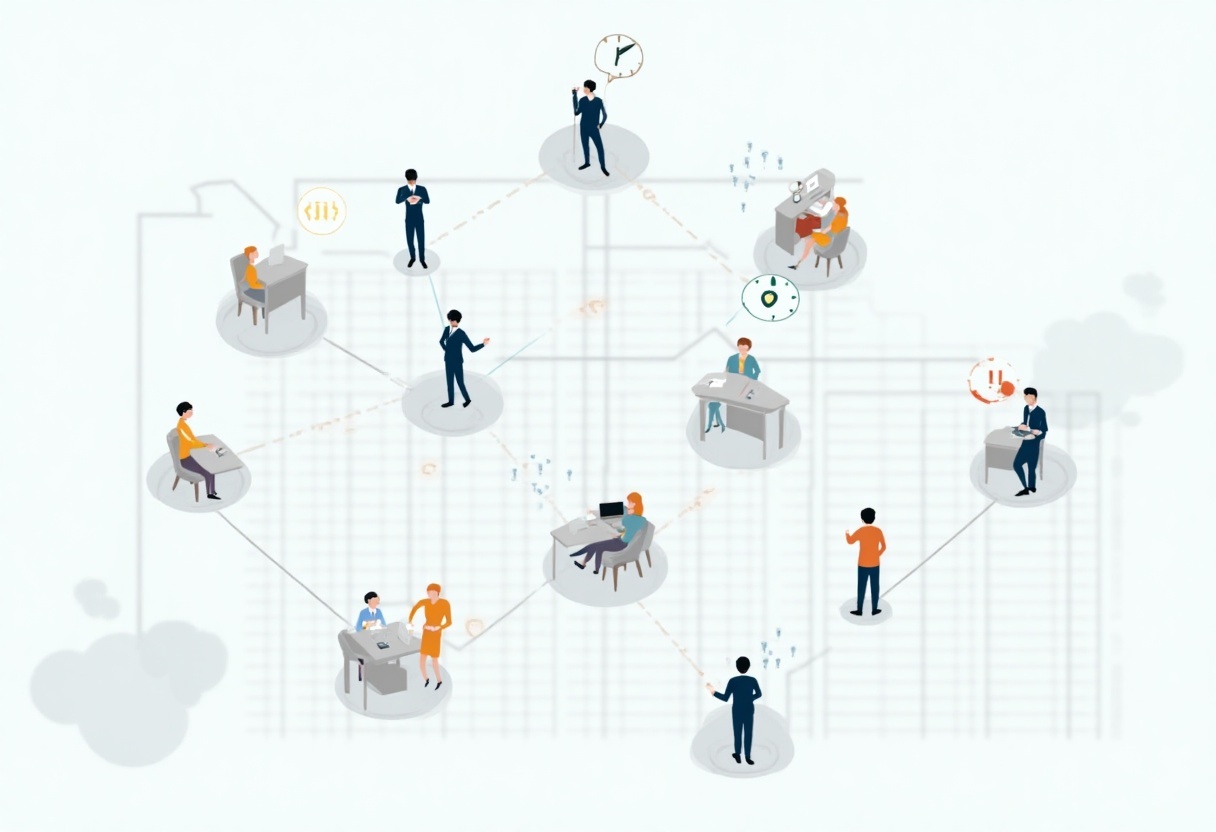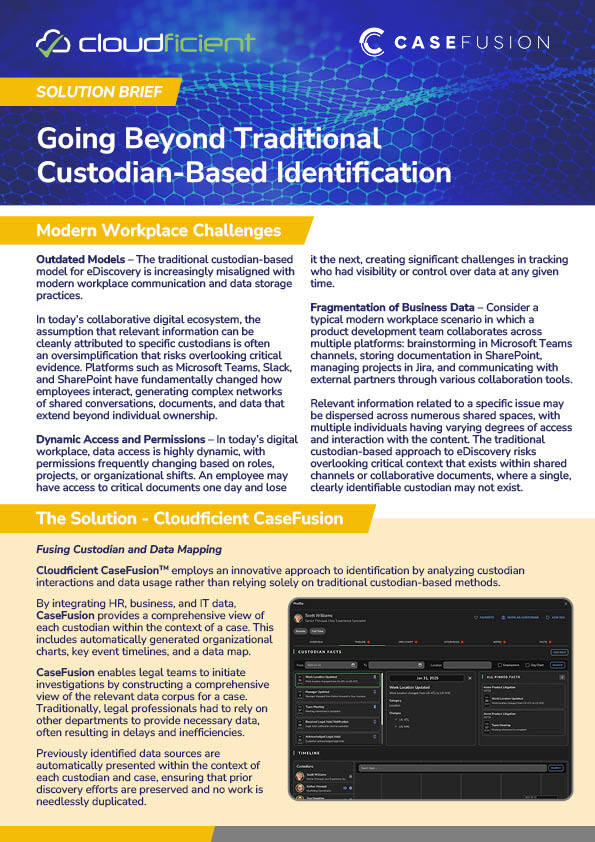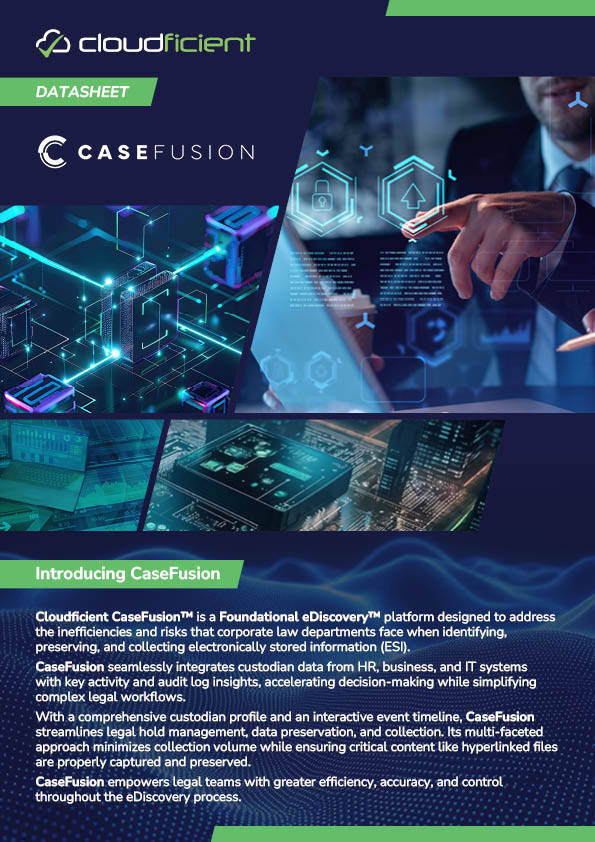- Solutions
- Foundational eDiscovery
- Legal Hold Management
Legacy Legal Hold Wasn't Built for Today's Complex Data Landscape
Without proper legal hold technology, organizations are left to solve these challenges with multiple tools, expensive third-party teams, and manual effort.
What Legal Hold Often Fails to Address — And Why It Matters
In today's data-driven legal landscape, the risks of non-compliance are severe, and ensuring defensible data preservation is paramount. Organizations face critical challenges when implementing litigation holds, sometimes even with existing solutions in place.
Preserving Data Across Multiple Systems and Custodians
Modern legal holds must account for data spread across fragmented systems and evolving workflows. Key challenges include:
-
-
Disparate data sources: Email, cloud storage, messaging apps, mobile devices, and legacy systems often lack unified preservation workflows.
-
Custodian complexity: Identifying relevant custodians and tracking employee changes (e.g., role shifts, departures) creates preservation blind spots.
-
Overlapping holds: Coordinating multiple legal holds across departments increases the chance of inconsistency and non-compliance.
-
Disconnected tools: Siloed systems and manual processes open up security gaps and hinder defensibility.
-
Modern file formats: Hyperlinked content (e.g., from SharePoint or Teams) often escapes traditional capture methods, risking incomplete holds.
-


Effective Legal Hold Notifications
Even with sound preservation policies, many organizations face critical breakdowns in the legal hold notification process. Common challenges include:
-
Inconsistent messaging: Vague or overly legalistic language leads to confusion about obligations.
-
Manual workflows: Reliance on spreadsheets and informal follow-ups increases the risk of human error and compliance gaps.
-
Lack of visibility: Without centralized tracking, it’s difficult to confirm acknowledgment or monitor compliance in real time.
-
No escalation process: Custodians who ignore notices often slip through the cracks, risking noncompliance and potential data loss.
Without automation and standardization, organizations can't ensure timely, defensible custodian communication, putting them at risk. Technology that addresses these gaps is no longer optional.
Ensuring Custodian Compliance
Even with proper notifications in place, ensuring custodian compliance remains a major challenge. Many organizations struggle with inconsistent enforcement, lack of clear expectations, and minimal training, leading to costly mistakes.
Compliance risks escalate when:
-
Responsibilities are unclear: Custodians don’t fully understand their obligations or the scope of a legal hold.
-
Timing is off: Preservation expectations aren’t communicated clearly, or early enough to be effective.
-
Processes don’t scale: High turnover, remote teams, or complex org structures aren't accounted for in compliance workflows.
-
Follow-through is missing: There’s no system for reinforcing, monitoring, or auditing custodian behavior over time.
Without ongoing education and accountability, even the best legal hold processes can break down over time.


Limitations of Legal Hold Tools
Many legacy tools, like Microsoft Purview and Google Vault, weren’t designed for the complexity of modern legal holds. Confined to their own ecosystems, they lack the flexibility to manage data from platforms like Slack, Zoom, or other cloud-based collaboration tools.
These systems rely heavily on manual processes, such as spreadsheets, email chains and disconnected workflows. As a result, these tools introduce risk and inefficiency:
-
Limited visibility: Legal teams struggle to get a real-time, centralized view of hold activity.
-
Weak audit trails: Inadequate logging makes defensibility difficult during audits or litigation.
-
Minimal custodian tracking: There's no robust way to manage compliance, reminders, or escalations.
They lack the automation, lifecycle management, and legal-specific controls that modern legal hold platforms provide, leaving teams underserved and exposed.
Inefficient Workflows
Manual legal hold processes place a heavy burden on legal and IT teams. Without automation, teams must manage every step by hand, creating inefficiencies and compliance risks.
Key challenges include:
-
Time-consuming tasks: Tracking acknowledgments, issuing reminders, and updating hold status manually take significant time.
-
Fragmented systems: Managing data preservation across siloed platforms increases complexity and the chance of oversight.
-
Administrative overload: Skilled professionals are stuck performing repetitive, low-value work instead of focusing on higher-level legal strategy.
-
Increased risk of error: Manual processes are prone to mistakes that can compromise defensibility and slow legal response times.
-
Unsustainable at scale: As legal hold volume grows, resource strain escalates, impacting compliance and operational efficiency.


Improperly Preserved Data
Poorly managed legal holds don’t just create inefficiencies, they expose organizations to significant legal, financial, and operational risks.
Common issues include:
-
Over- or under-collection: Collecting too much data inflates storage costs; collecting too little increases the risk of non-compliance.
-
Balancing preservation with privacy: As regulations tighten, organizations must preserve data without violating privacy or security requirements.
-
Data integrity risks: Inadequate processes can result in altered, corrupted, or lost data, undermining defensibility.
-
Incomplete audit trails: Gaps in documentation make it difficult to prove compliance during audits or litigation.
-
Legal and regulatory exposure: Failures in preservation can lead to sanctions, fines, or adverse legal outcomes.
Adopt a Proactive Information Governance Strategy
Implement proactive information governance by regularly purging outdated data to reduce eDiscovery burdens. During a legal hold, suspend any conflicting automated deletions and coordinate with IT and records teams for compliance. Once the matter is resolved, formally release the hold, document the conclusion, and resume normal data retention practices.
Centralize & Standardize the Legal Hold Process
Establish a centralized and well-documented legal hold process as part of your overall compliance strategy. Define roles, communication methods, and compliance monitoring clearly. Use legal hold software to automate, track, and scale the process, ensuring consistency, efficiency, and defensibility across the organization.
Leverage Modern Data Management and Preservation Tools
Utilizing automated legal hold software and data mapping tools can enhance efficiency and defensibility in the legal hold process.
Identify & Notify Relevant Custodians Promptly
Promptly identify and notify all relevant custodians as soon as litigation or investigation is anticipated. Timely action prevents data loss and legal risks. Carefully determine key individuals and data sources, and continuously update the scope to ensure comprehensive preservation.
Maintain Ongoing Communication & Collaboration with Custodians
Maintain clear, ongoing communication with custodians to ensure they understand their responsibilities and stay compliant. Use clear, standardized notices, provide regular reminders, and offer support to address questions or concerns effectively.
Train Employees on Legal Hold Responsibilities
Training programs can help employees understand the importance of legal holds and their role in preserving relevant data.
Track, Monitor & Document Legal Hold Compliance
Track and document legal hold compliance using automated tools to reduce errors and improve efficiency. Require custodians to acknowledge holds, send regular reminders, and maintain detailed audit trails. Monitor compliance actively and address any issues to ensure defensibility.
Keep Detailed, Auditable Records of All Legal Hold Actions
Maintain thorough documentation of all legal hold actions, including issuance, acknowledgments, follow-ups, and enforcement. A detailed audit trail is essential for demonstrating compliance and defending against legal challenges.
Our Solutions
Cloudficient's integrated legal hold technology addresses the challenges with two complementary solutions that transform manual, error-prone processes into automated, defensible workflows.
CaseFusion - A comprehensive eDiscovery platform that unifies custodian identification, automated hold notifications with escalation workflows, real-time compliance dashboards, and defensible audit trails. Organizations gain centralized legal hold management across enterprise data ecosystems with proactive alerts, automated reminders, and comprehensive documentation that satisfies court expectations.
Expireon - A cloud-native data archiving platform designed to fill gaps in governance tools like Microsoft Purview. Expireon provides a defensible, compliant home for email, messaging platforms, and file systems with custom retention periods, native format storage, and cost-effective pricing based on data volume rather than user licenses.
Together, these solutions ensure impeccable compliance while mitigating risk and simplifying complexity across your organization's legal hold processes.
Frequently Asked Questions
What is a legal hold?
Legal holds are internal processes an organization uses to support its duty to preserve potentially relevant information when litigation, regulatory action, or contractual obligations are reasonably anticipated. While the legal hold itself does not create the obligation to preserve, it is how organizations operationalize that obligation in a defensible manner.
What is a litigation hold?
A litigation hold is the same as a legal hold. The terms can be used interchangeably. Both of these terms refer to the same legal concept and process. Some organizations use one term over the other, but they have identical meanings and requirements.
Why do legal holds matter?
Legal holds are critical for protecting organizations from severe legal and financial consequences during litigation. Without proper legal holds, organizations face spoliation sanctions that can include adverse inference instructions, case dismissals, default judgments, and substantial monetary penalties.
Beyond direct legal consequences, failure to implement effective legal holds can damage an organization's reputation and credibility in court. Legal holds also ensure organizations can present complete evidence to support their defense or claims, potentially affecting case outcomes and settlement negotiations. In today's complex data environment, legal holds have become essential for litigation readiness and risk management, helping organizations demonstrate good faith preservation efforts and maintain defensible litigation positions.
What is a legal hold notice?
A legal hold notice is a formal communication sent to employees and custodians instructing them to preserve specific types of information related to potential or actual litigation.
The notice explains what documents and data must be preserved, the time period covered, and the consequences of non-compliance. Legal hold notices must be clear, specific, and include instructions on how custodians should handle their preservation obligations throughout the litigation process.
.png?width=620&height=82&name=Untitled%20design%20(18).png)
.png?width=600&height=79&name=Untitled%20design%20(18).png)





